Glass House Mountains, Queensland facts for kids
Quick facts for kids Glass House MountainsSunshine Coast, Queensland |
|||||||||||||||
|---|---|---|---|---|---|---|---|---|---|---|---|---|---|---|---|

Mount Beerwah, 2005
|
|||||||||||||||
| Population | 5,601 (2021 census) | ||||||||||||||
| • Density | 76.62/km2 (198.4/sq mi) | ||||||||||||||
| Postcode(s) | 4518 | ||||||||||||||
| Area | 73.1 km2 (28.2 sq mi) | ||||||||||||||
| Time zone | AEST (UTC+10:00) | ||||||||||||||
| Location |
|
||||||||||||||
| LGA(s) | Sunshine Coast Region | ||||||||||||||
| County | Canning | ||||||||||||||
| Parish | Beerwah | ||||||||||||||
| State electorate(s) | Glass House | ||||||||||||||
| Federal Division(s) | Fisher | ||||||||||||||
|
|||||||||||||||
Glass House Mountains is a small town in the Sunshine Coast area of Queensland, Australia. It's known for its beautiful natural scenery, especially the tall, pointy mountains that give it its name. In 2021, about 5,601 people lived here.
Contents
Exploring the Glass House Mountains Area
This town has a train station where you can catch trains heading north towards other parts of Queensland or south to Brisbane. The main Bruce Highway also runs nearby, making it easy to travel by car. Another important road, Glass House Mountains Road (also called Steve Irwin Way), goes right through the town from south to north.
A Look Back at Glass House Mountains History
Early Land Sales and Pineapple Farms
In 1903, the Queensland Government sold land around the Glass House Mountains train station. Many of these plots were about 5 acres, perfect for starting pineapple farms. This area was then part of the Beerwah parish.
School Days in Glass House Mountains
The first school, Glass Mountains Provisional School, opened on April 17, 1906. It closed briefly in 1907 because not enough students attended. It reopened as Glass Mountains State School in 1910. The school's name changed a few times, finally becoming Glass House Mountains State School in 1935.
Local Churches and Community
All Saints' Anglican church opened in 1939 but closed around 1993. The building was later moved. In 2000, several local churches joined together to form the Glasshouse Country Uniting Church in nearby Beerwah.
Population of Glass House Mountains
In 2016, the town of Glass House Mountains had a population of 5,065 people. By 2021, the population grew to 5,601 people.
Important Heritage Sites
Glass House Mountains has some special places that are protected for their history. These include:
- Bankfoot House on Old Gympie Road, a historic home.
- Parts of the Glass House Mountains National Park and Beerburrum Forest Reserve on Barrs Road, which protect the natural environment.
Education in Glass House Mountains
Glass House Mountains State School is a primary school for students from Prep to Year 6. It's located at 58 Coonowrin Road. In 2018, the school had about 391 students. For high school, students usually go to Beerwah State High School in the nearby town of Beerwah.
Community Life and Amenities
The Glass House Mountains Community Hall is a central meeting place at 8 Coonowrin Road. The Sunshine Coast Regional Council also brings a mobile library service to the Community Hall regularly. Cornerstone Church, part of the Wesleyan Methodist Church of Australia, holds its meetings at the Community Hall. Soccer is a very popular sport here, brought by early European farmers. The local soccer fields were even built with help from farmers donating resources.



